Detection
A 50 dBZ Echo Top signature refers to the height of the highest echo that is greater than 50 dBZ within a storm’s radar reflectivity core. This signature can be found in any thunderstorm with echoes of at least 50 dBZ. One reason for determining if this signature is present is to see whether a storm's 50 dBZ core, which is likely to represent hail when located above the freezing level, reaches into or beyond the hail growth layer (-10°C to -30°C).
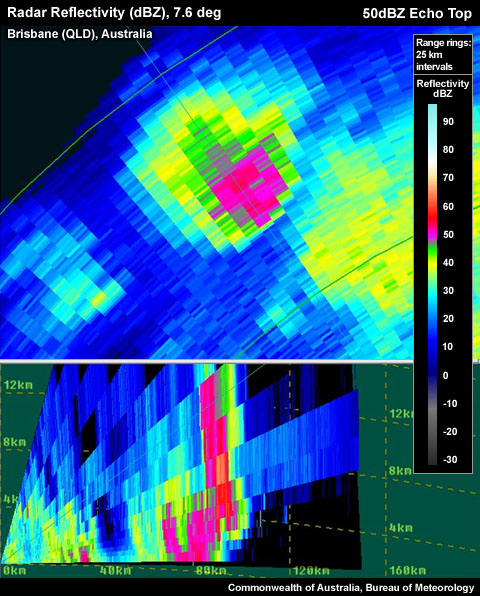
The 50 dBZ Echo Top Height signature in this example shows echoes above 50 dBZ high in the atmosphere, extending into the hail growth layer and increasing the likelihood that the targets are large hail. The thunderstorm in this reflectivity image has 50 dBZ and greater echoes extending to around 12km.
The 50 dBZ echo height can be determined as follows:
Reflectivity: PPI/Plan View
- Step up in elevation scans until you run out of >50 dBZ echoes.
- Step back down one elevation scan.
- Centre cursor over the >50 dBz pixel furthest away from the radar. Read off the height. Note: In 3D-Rapic this can be done using the scale bar on the right of display, the info bar at the bottom of display or via the cursor data on the main control window.
The 50 dBZ echo top signature can also be used as a monitoring tool for forecasters. The following technique requires the use of environmental parameters in conjunction with a Constant Altitude PPI (CAPPI) window. The basic idea of this monitoring technique is to place a CAPPI level into the middle to upper parts of the hail growth layer and to monitor for significant (>50 dBZ) reflectivity cores to grow beyond the CAPPI level as an indicator for storm severity. In this technique, rather than placing the CAPPI at the -20°C level, a Sydney-based climatology is used (the "hail nomogram"). In this climatology, hail size reports are plotted as a function of the corresponding 50 dBZ echo top heights of the corresponding storm and the proximity environmental freezing levels. Threshold lines for 2, 4 and 6 cm hail are fitted subjectively (see step 2 below). The CAPPI height is determined as follows:
- Choose a representative environmental proximity sounding for the thunderstorm outlook area. Find the height of the environmental freezing level.
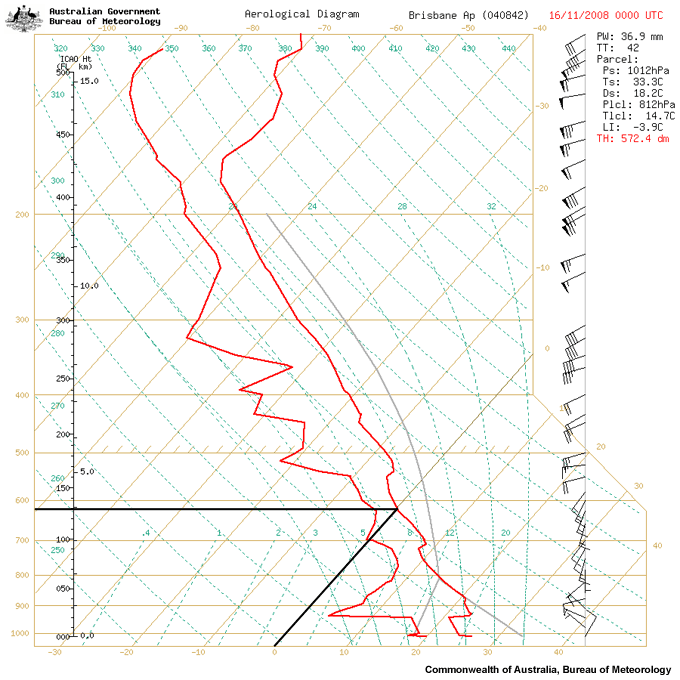
Representative proximity sounding used to determine the environmental freezing level required for the hail nomogram. The freezing level for the Brisbane area on 16 November 2008 was approximately 4 km.
- Using the Australian Climatology 50 dBZ hail nomogram, read off the critical height for 2cm hail (threshold for severe weather) using the freezing level determined from the sounding in step 1.
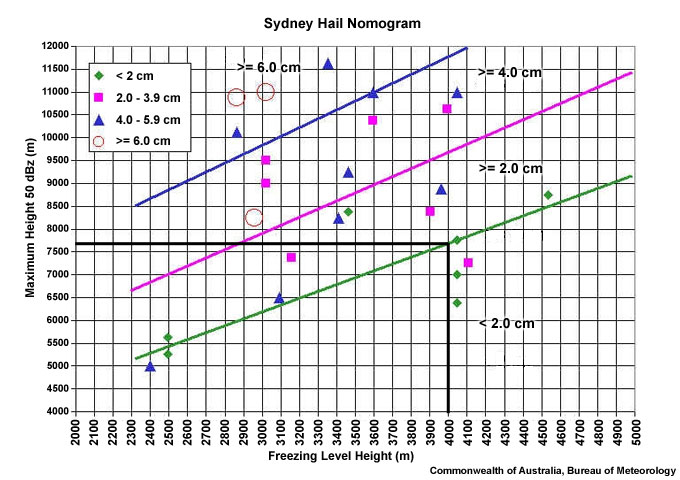
The hail nomogram is based on a hail climatology specific to the Sydney region, Australia. It was derived from observations using the 2º beam width S-band Sydney radar. There are several other limitations that need to be taken into consideration when using this nomogram, including:
- Single station climatology performed on a S-band radar
- Relatively small sample size used
- Radars are can be poor in calculating heights of target, due to:
- Partial beam filling
- Varying beam widths
- Refraction
- Add a CAPPI window to your radar display and set the height to the 2cm hail threshold altitude from step 2.
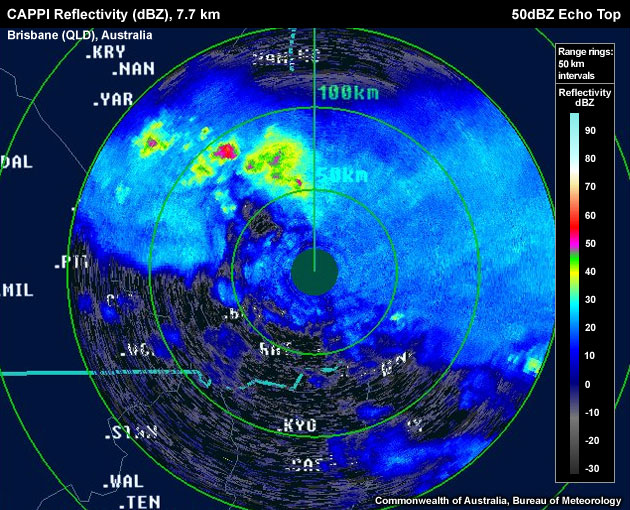
50 dBZ thunderstorm tops "breaking through the CAPPI" level set at the 2cm hail threshold height indicating the likelihood of large hail.
- Monitor the CAPPI window for breakthroughs of >50 dBZ echoes as candidate storms for further investigation.
Potential Difficulties in Detection
Radar Sampling:
- Calibration – with most colour palettes for reflectivities, values close to 50 dBZ start being displayed in reddish colours. If the radar underreads the reflectivity by only a few dBZ, 50 dBZ echo tops may be off by several kilometres
- Attenuation – especially on C–band radars, reflectivities in cores that are located down–range of another intense core are underestimated in intensity.
- Radar proximity – if a thunderstorm is too close to the radar, the beam may undershoot the signature
Examples of 50 dBZ Echo Top Heights
Note: The CAPPI height is not the "50 dBZ echo top height". To determine the "50 dBZ echo top height", place the cursor on the pixel and read off on the info bar at the base of the window.
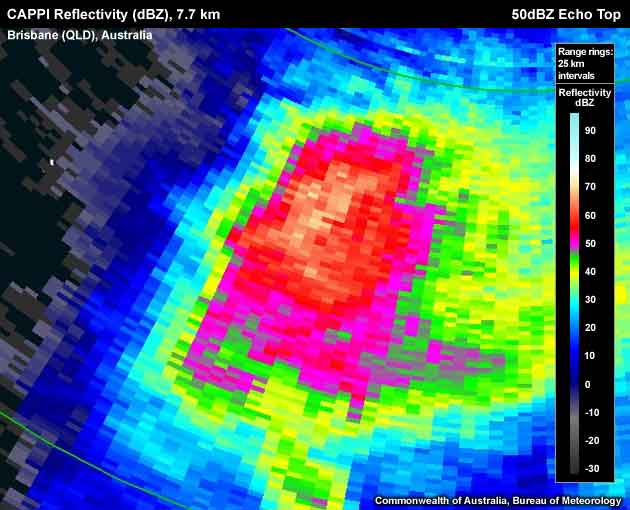
A large horizontal extent of very high reflectivities breaking through the 2 cm hail height on a CAPPI. The highest reflectivity is approximately 69.0 dBZ
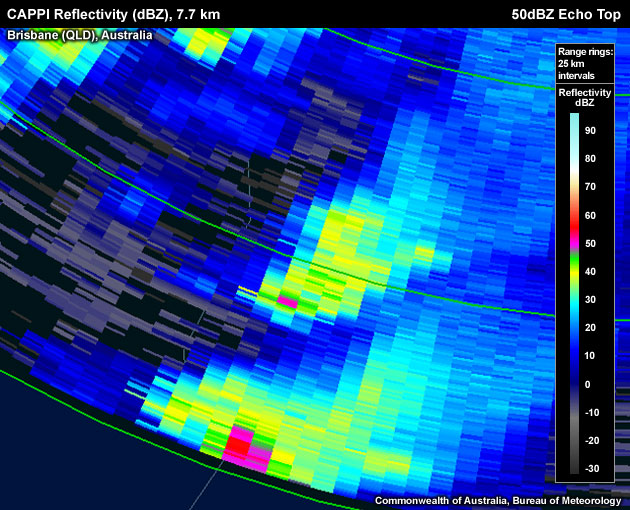
A few pixels with reflectivities greater than 50 dBZ breaking through the 2 cm hail height on a CAPPI. The highest reflectivity is approximately 50.5 dBZ. Note: a "single pixel breakthrough" is obviously a lot less meaningful than several pixels as shown above.
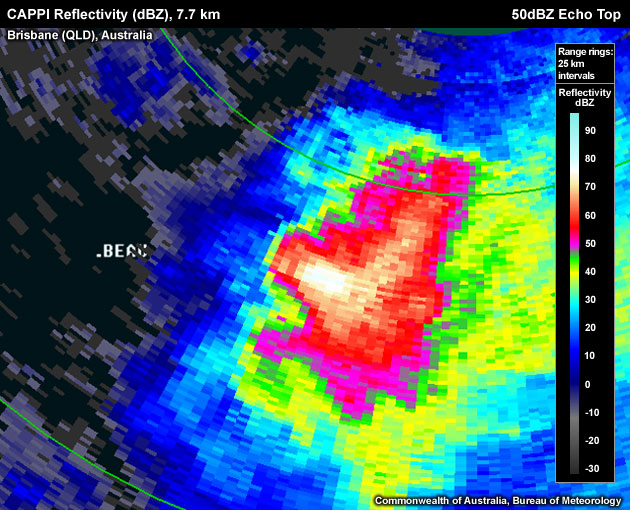
A large horizontal extent of very high reflectivities breaking through the 2 cm hail height on a CAPPI. The highest reflectivity is approximately 77.0 dBZ
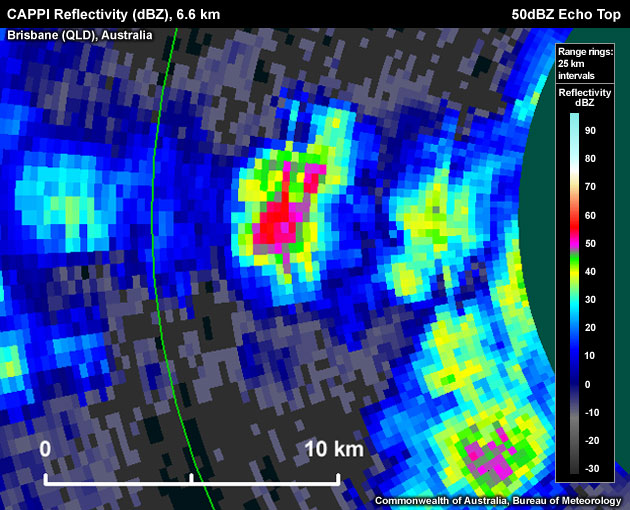
Small horizontal extent of reflectivities greater than 50 dBZ breaking through the 2 cm hail height on a CAPPI. The highest reflectivity is approximately 59.0 dBZ.
50 dBZ Echo Top Height Look–a–likes
- A small number of pixels – when using the 50 dBZ signature through the CAPPI techniques, a small number of 50+ dBZ pixels in the CAPPI level, amounting to a small red area of approximately 1 km2 or less, is not that meaningful as a proxy for 2 cm hail at the ground.
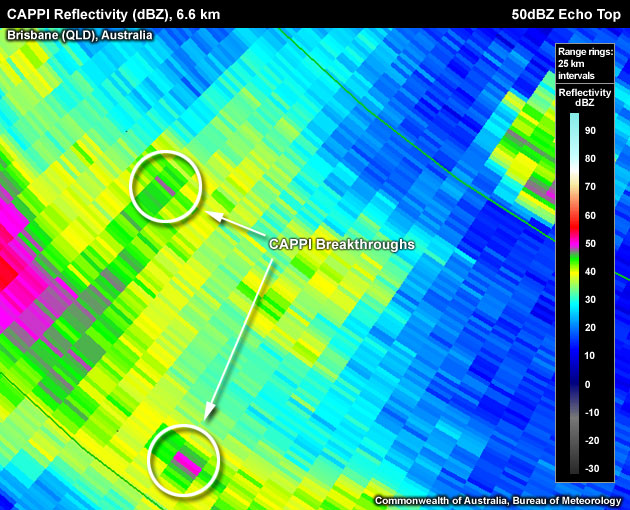
A small horizontal extent of pixels breaking through the CAPPI provides small confidence on large hail reaching the ground.
- Weak Reflectivities – echoes need to be greater than or equal to 50 dBZ. The standard Australian coulour palette uses a dark pink for pixels with reflectivities greater than about 45 dBZ. These can easily be mistaken for pixels with reflectivity values at or above 50 dBZ.
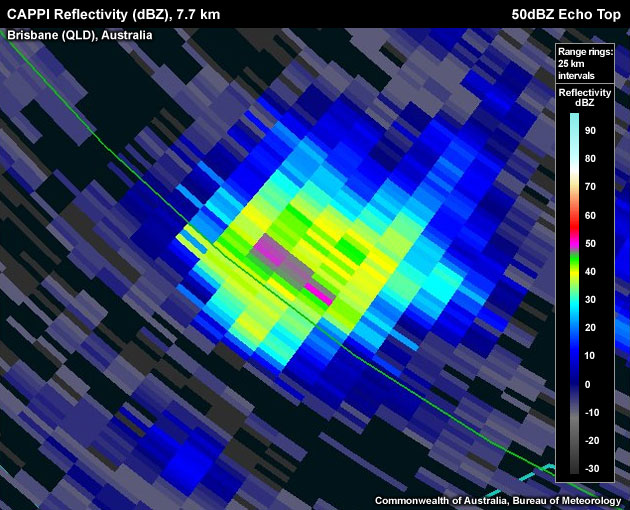
Relatively weak (less than 50 dBZ) but "reddish" reflectivities breaking through the CAPPI provide small confidence on large hail reaching the ground.
